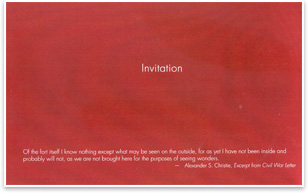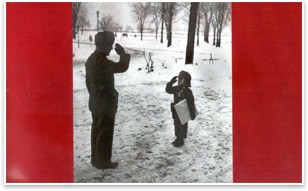
HGA Wins SMPS Best of Show Marketing Award
by Zach Mortice
Summary: HGA’s proposal for a new visitors’ center and museum at Minnesota’s Fort Snelling won SMPS’s Best of Show marketing award this summer. The proposal used in-depth historical research to stitch together archival-styled documents that demonstrated the firm’s understanding of the fort’s past and present a compelling vision of its future. It used many photos from the client’s own archives to ground their efforts in the historical narrative of Fort Snelling. Hammel, Green, and Abrahamson’s marketing victories reaffirm a simple maxim: You’ve got to understand the past to have a stake in shaping the future. The Minneapolis-based architecture firm’s proposal for a new visitors’ center and museum at Fort Snelling in St. Paul won the Society for Marketing Professional Services (SMPS) Specific Project Marketing category, and then competed against 17 other category winners to take the Best of Show award. SMPS is the professional marketing association for the architecture, engineering, and construction industries. HGA’s proposal is grounded in archival research and historical narratives that tell the story of Fort Snelling, Minnesota’s first National Historic Landmark. The new museum’s designer, Joan Soranno, AIA, dug into the client’s (the Minnesota Historical Society) own archives for photographs and information about the groups of people that have shaped the land of Fort Snelling even before its founding in the early 19th century. Located on a limestone bluff overlooking the confluence of the Minnesota and Mississippi Rivers, the land that would become Fort Snelling was a meeting place, trading ground, and center of commerce for Native Americans, and later for the white settlers who used the military installation. The fort’s river access made it a transportation hub and a vital outpost for the tide of colonization that washed across the northern United States. Transport and commerce are still vital to the area. Today, the fort sits next to the Mall of America and the Minneapolis-St. Paul International Airport.
Her Fort Snelling proposal didn’t just turn heads at the SMPS jury. The Minnesota Historical Society also embraced the proposal, and selected HGA to design and renovate the new Fort Snelling. “[HGA] had really taken the care to understand what the nature and the scope of the project was going to be,” says Heather Koop, the Historical Society’s Director of Southern Minnesota Historic Sites. The story of the land The signature element of Soranno’s marketing pitch is a handmade, hardbound booklet that pairs these archival photos with literary and historical quotes. Each pairing is combined with a simple, thematic word (“memory,” “invitation,” “respect,” etc.) that Soranno found to be particularly applicable to the project. The page marked “Transformation” contains a quote from T.S. Eliot: “We shall never cease from exploration and the end of all our exploring will be to arrive where we started and know the place for the first time.” On the opposite page, workers till the grounds of the fort while ivy creeps over the walls of a crenulated turret behind them.
Kristen Richards, a member of the SMPS Best of Show jury, says this bored, institutional tone is a common pitfall in architectural marketing materials, though certainly not with HGA’s proposal. She said the firm’s booklet was one of the few proposals she has ever seen that she might want to take home. “It’s like a souvenir,” says Richards, editor in chief of ArchNewsNow.com and of Oculus, AIA New York’s quarterly newsletter. “It’s something I would put on my bookshelf.” Fellow jury member Richard Belle, the chief marketing and communications officer for the American Council of Engineering Companies, praised the project for its subtlety. “[There was] a lot of gentle persuasion that indicated a lot of conscientious due diligence and creativity on the part of the firm,” he says. Beyond the building |
||
Copyright 2007 The American Institute of Architects. All rights reserved. Home Page |
||



